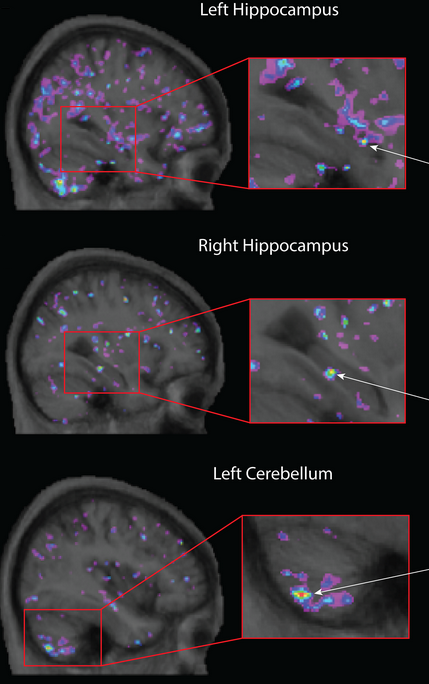Video games and piano lessons improve cognitive functions in seniors, researchers find
December 13, 2017

(credit: Nintendo)
For seniors, playing 3D-platform games like Super Mario 64 or taking piano lessons can stave off mild cognitive impairment and perhaps even prevent Alzheimer’s disease, according to a new study by Université de Montréal psychology professors.
In the studies, 33 people ages 55 to 75 were instructed to play Super Mario 64 for 30 minutes a day, five days a week for a period of six months, or take piano lessons (for the first time in their life) with the same frequency and in the same sequence. A control group did not perform any particular task.
The researchers evaluated the effects of the experiment with cognitive performance tests and magnetic resonance imaging (MRI) to measure variations in the volume of gray matter.

Increased gray matter in the left and right hippocampus and the left cerebellum after older adults completed six months of video-game training. (credit: Greg L. West et al./PLoS One)
- The participants in the video-game cohort saw increases in gray matter volume in the cerebellum (plays a major role in motor control and balance) and the hippocampus (associated with spatial and episodic memory, a key factor in long-term cognitive health); and their short-term memory improved. (The hippocampus gray matter acts as a marker for neurological disorders that can occur over time, including mild cognitive impairment and Alzheimer’s.)
- There were gray-matter increases in the dorsolateral prefrontal cortex (controls planning, decision-making, and inhibition) and cerebellum of the participants who took piano lessons.
- Some degree of atrophy was noted in all three areas of the brain among those in the passive control group.
“These findings can also be used to drive future research on Alzheimer’s, since there is a link between the volume of the hippocampus and the risk of developing the disease,” said Gregory West, an associate professor at the Université de Montréal and lead author of an open-access paper in PLoS One journal.
“3-D video games engage the hippocampus into creating a cognitive map, or a mental representation, of the virtual environment that the brain is exploring,” said West. “Several studies suggest stimulation of the hippocampus increases both functional activity and gray matter within this region.”
However, “It remains to be seen whether it is specifically brain activity associated with spatial memory that affects plasticity, or whether it’s simply a matter of learning something new.”
Researchers at the Memorial University in Newfoundland, and Montreal’s Douglas Hospital Research Centre were also involved in the study.
In two previous studies by the researchers in 2014 and 2017, young adults in their twenties were asked to play 3D video games of logic and puzzles on platforms like Super Mario 64. Findings showed that the gray matter in their hippocampus also increased after training.
Abstract of Playing Super Mario 64 increases hippocampal grey matter in older adults
Maintaining grey matter within the hippocampus is important for healthy cognition. Playing 3D-platform video games has previously been shown to promote grey matter in the hippocampus in younger adults. In the current study, we tested the impact of 3D-platform video game training (i.e., Super Mario 64) on grey matter in the hippocampus, cerebellum, and the dorsolateral prefrontal cortex (DLPFC) of older adults. Older adults who were 55 to 75 years of age were randomized into three groups. The video game experimental group (VID; n = 8) engaged in a 3D-platform video game training over a period of 6 months. Additionally, an active control group took a series of self-directed, computerized music (piano) lessons (MUS; n = 12), while a no-contact control group did not engage in any intervention (CON; n = 13). After training, a within-subject increase in grey matter within the hippocampus was significant only in the VID training group, replicating results observed in younger adults. Active control MUS training did, however, lead to a within-subject increase in the DLPFC, while both the VID and MUS training produced growth in the cerebellum. In contrast, the CON group displayed significant grey matter loss in the hippocampus, cerebellum and the DLPFC.
